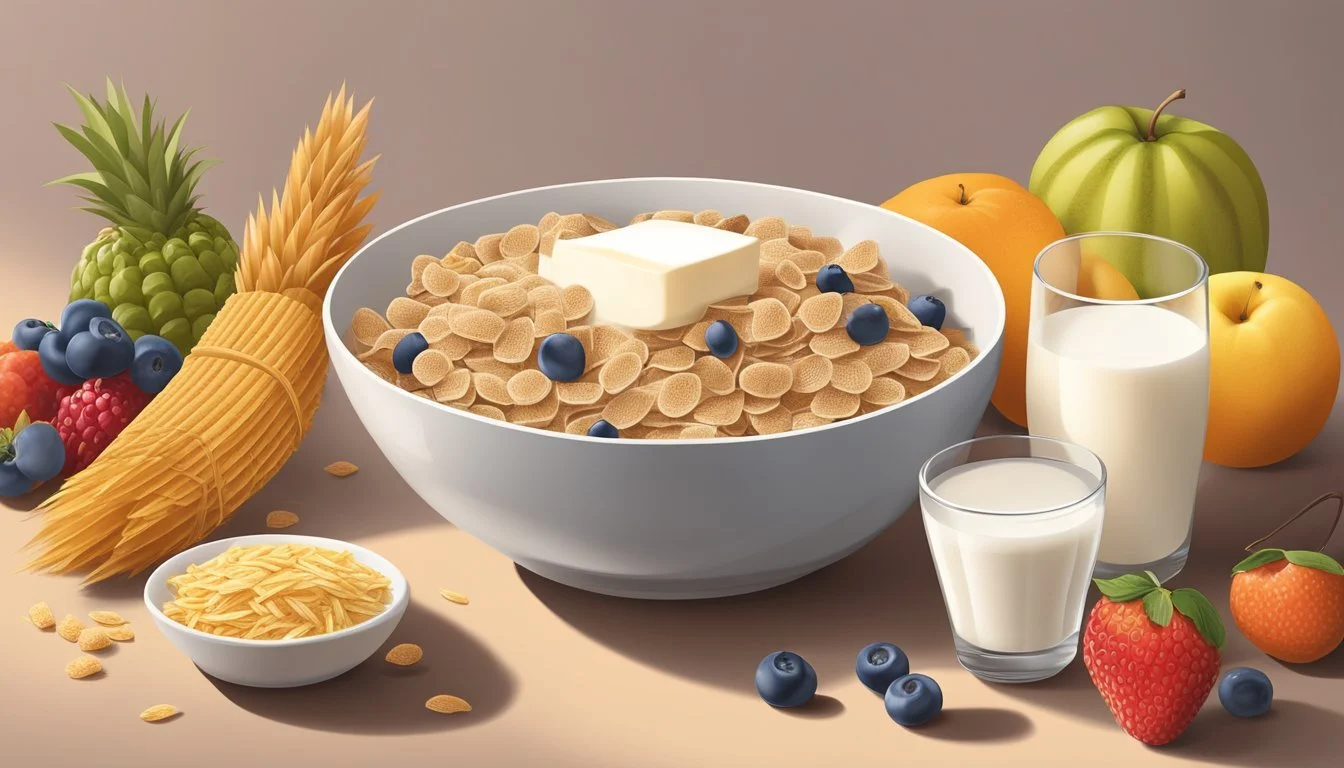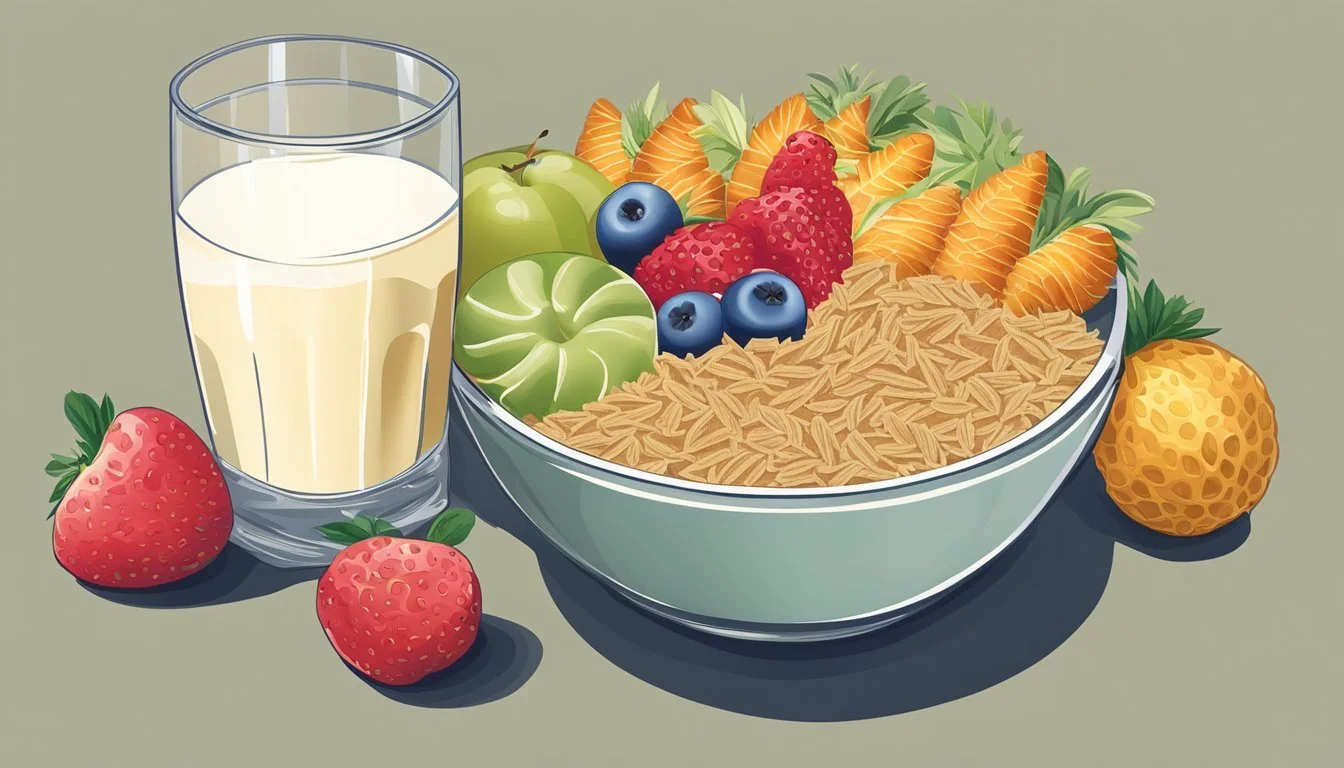Shredded Wheat Nutrition Facts & More
Essential Facts for a Healthy Diet
Shredded wheat cereal stands out as a nutritious breakfast option packed with essential nutrients. This simple whole grain food provides a hearty dose of fiber and protein to jumpstart your day. A single serving of shredded wheat contains about 6 grams of protein and is an excellent source of dietary fiber.
The nutrition profile of shredded wheat is particularly appealing for health-conscious consumers. It contains no added sugars, making it a smart choice for those watching their sugar intake. Shredded wheat also offers important minerals like iron and potassium, contributing to a well-rounded diet.
While shredded wheat offers many nutritional benefits, it's worth noting that it contains minimal amounts of certain vitamins and minerals. However, its whole grain composition still makes it a valuable addition to a balanced breakfast. When combined with milk or topped with fruits, shredded wheat can form part of a nutrient-dense meal to fuel your morning activities.
Nutritional Profile
Shredded wheat offers a balanced nutritional profile with whole grain goodness. It provides essential macronutrients and micronutrients while being low in sugar and fat.
Macronutrient Breakdown
Shredded wheat's macronutrient profile is dominated by complex carbohydrates. A typical 49-gram serving contains around 40 grams of total carbohydrates, with 6 grams of dietary fiber. This high fiber content promotes digestive health and feelings of fullness.
The cereal is low in fat, with only 1 gram per serving. Most of this fat is unsaturated, contributing to heart health. Protein content is moderate at 6 grams per serving, supporting muscle maintenance and repair.
Notably, shredded wheat contains no added sugars, making it a suitable choice for those monitoring their sugar intake.
Vitamins and Minerals
Shredded wheat provides several essential vitamins and minerals:
Iron: 8% of the Daily Value (DV)
Potassium: 4% DV
Calcium: 2% DV
The cereal is often fortified with additional nutrients, which may include:
B vitamins (thiamin, riboflavin, niacin, folate)
Vitamin D
Zinc
These micronutrients support various bodily functions, including energy metabolism, bone health, and immune system function.
Calories and Serving Size
A standard serving of shredded wheat (49 grams or about 1 cup) contains approximately 170-175 calories. This calorie content is moderate, making it a filling breakfast option that can be part of a balanced diet.
The serving size is important to note, as it affects the overall nutritional intake. One box typically contains about 8 servings, allowing for portion control and meal planning.
When consumed with milk, the calorie and nutrient content will increase. Adding fresh fruits can enhance the vitamin and fiber content while introducing natural sweetness.
Health Benefits
Shredded wheat offers numerous health benefits due to its whole grain composition and nutritional profile. This cereal can support digestive health, aid in weight management, and promote cardiovascular wellness.
Dietary Fiber and Digestion
Shredded wheat is high in dietary fiber, providing around 6 grams per serving. This fiber content supports healthy digestion by promoting regular bowel movements and preventing constipation.
Fiber also acts as a prebiotic, feeding beneficial gut bacteria. This can improve overall gut health and boost the immune system.
The insoluble fiber in shredded wheat adds bulk to stools, helping food move through the digestive tract more efficiently.
Weight Management
Shredded wheat can be a valuable addition to a weight loss diet. Its high fiber content increases satiety, helping people feel fuller for longer periods.
A serving of shredded wheat contains about 170 calories, making it a relatively low-calorie breakfast option. This can assist in calorie control for those aiming to lose or maintain weight.
The protein in shredded wheat, though modest at 4 grams per serving, contributes to muscle maintenance during weight loss efforts.
Cardiovascular Health
Whole grains like those in shredded wheat are associated with reduced risk of cardiovascular disease. The fiber in shredded wheat can help lower cholesterol levels in the blood.
Shredded wheat is naturally low in sodium and contains no saturated or trans fats, making it heart-healthy. These qualities can contribute to better blood pressure control.
Regular consumption of whole grains has been linked to a decreased risk of stroke and heart disease in numerous studies.
Dietary Considerations
Shredded wheat offers several nutritional benefits but also has important dietary factors to consider. Its composition impacts various health needs and dietary restrictions.
Whole Grains and Gluten Content
Shredded wheat is made from 100% whole grain wheat, providing essential nutrients and fiber. A single serving contains about 6 grams of fiber, contributing to digestive health and satiety. The whole grain content supports heart health and may help reduce the risk of chronic diseases.
However, shredded wheat is not suitable for those with celiac disease or gluten sensitivity. It contains gluten, a protein found in wheat, barley, and rye. People following a gluten-free diet must avoid this cereal and opt for gluten-free alternatives.
Sugar and Presweetened Varieties
Plain shredded wheat contains no added sugars, making it an excellent choice for those monitoring sugar intake. This feature is particularly beneficial for individuals managing diabetes or trying to reduce overall sugar consumption.
Some brands offer presweetened varieties of shredded wheat. These versions contain added sugars, which can significantly alter the nutritional profile. For example:
Plain shredded wheat: 0g sugar per serving
Presweetened varieties: Up to 12g sugar per serving
It's crucial to read labels carefully when choosing shredded wheat products to align with dietary goals.
Sodium Content and Blood Pressure
Shredded wheat is naturally low in sodium, with most varieties containing less than 5mg per serving. This low sodium content makes it an ideal choice for individuals managing hypertension or following a low-sodium diet.
The minimal sodium in shredded wheat can contribute to better blood pressure control. It also allows for more flexibility in sodium intake from other food sources throughout the day.
For those requiring stricter sodium limitations, plain shredded wheat can be a reliable breakfast option. It provides essential nutrients without compromising sodium intake goals.
Consumption Tips
Shredded wheat offers nutritional benefits when consumed as part of a balanced diet. Proper serving sizes and thoughtful pairings can enhance its value in a meal plan.
Pairing with Other Nutritious Foods
Adding fresh fruits to shredded wheat boosts its nutritional profile. Berries, sliced bananas, or diced apples provide natural sweetness and additional vitamins. Nuts or seeds sprinkled on top increase protein and healthy fats.
Low-fat milk or plant-based alternatives offer calcium and protein. For a protein-rich breakfast, combine shredded wheat with Greek yogurt.
A drizzle of honey or a sprinkle of cinnamon can enhance flavor without excessive added sugars.
Portion Sizes and Frequency
The nutrition facts panel on shredded wheat boxes typically lists a serving size of 1 to 1.5 cups. This serving provides about 6 grams of protein and significant fiber.
For weight management, measure portions using a measuring cup. Eating shredded wheat 3-4 times a week as part of a varied diet can contribute to daily whole grain intake.
Consume shredded wheat earlier in the day to benefit from its energy-providing carbohydrates. Pair it with protein sources to create a more filling meal.
Variants and Flavors
Shredded wheat comes in several varieties to suit different tastes and nutritional needs. The cereal maintains its core wheat base while offering both plain and flavored options.
Original Unflavored Variants
Plain shredded wheat provides a simple, wholesome breakfast choice. The original version consists of large biscuits made from 100% whole wheat. Spoon-size shredded wheat offers smaller, more manageable bites. Both variants contain no added sugars or flavors, allowing the natural taste of wheat to shine through.
These unflavored options are often favored by those seeking a low-sugar, high-fiber cereal. They can be customized with fresh fruits, nuts, or a drizzle of honey for added flavor.
Flavored and Fortified Options
For those who prefer sweeter cereals, frosted shredded wheat adds a layer of sugar to the wheat biscuits. This variant comes in various flavors like original frosted, strawberry, and maple.
Some brands offer chocolate-flavored shredded wheat, appealing to those with a sweet tooth. Fortified versions of shredded wheat may include added vitamins and minerals to boost nutritional value.
These flavored options typically contain more sugar than plain variants but still provide whole grain benefits. They offer a middle ground between nutritious whole wheat and more indulgent breakfast choices.
Comparative Analysis
Shredded wheat cereal stands out among breakfast options for its nutritional profile and versatility in various diets. Its simple ingredients and high fiber content set it apart from many other cereals on the market.
Against Other Breakfast Cereals
Shredded wheat contains 100% whole grain wheat, offering more fiber and protein than many sugar-laden alternatives. With 6 grams of fiber per serving, it surpasses cereals like Apple Pie Toast Crunch or Fruity Cereal, which often have 1-2 grams. Shredded wheat provides 6 grams of protein per serving, comparable to Wheaties Protein.
Unlike sugary options, shredded wheat has no added sugars, making it a healthier choice for those watching their sugar intake. Its sodium content is negligible, contrasting with many cereals that add salt for flavor enhancement.
Nutrient Shredded Wheat Average Sugary Cereal Fiber 6g 1-2g Protein 6g 2-3g Sugar 0g 10-15g
Shredded Wheat and Other Diets
Shredded wheat fits well into various diet regimens due to its simple, whole-grain composition. For weight loss efforts, its high fiber content promotes satiety, potentially reducing overall calorie intake. The absence of added sugars aligns with low-sugar diets.
While not keto-friendly due to its carbohydrate content, shredded wheat supports balanced, whole-food diets. It serves as an excellent base for customization, allowing additions like fruits or nuts to suit different nutritional needs.
For those seeking gluten-free options, shredded wheat is not suitable as it contains wheat. However, its whole grain nature makes it a valuable component of heart-healthy diets focused on increasing fiber intake.
Legal and Brand Information
Shredded Wheat's legal status and intellectual property rights are important aspects of its brand identity. These elements protect the cereal's name and unique attributes in the marketplace.
Trademark and Intellectual Property
The Shredded Wheat trademark is a valuable asset owned by Post Consumer Brands in the United States. This trademark covers the cereal's name and distinctive appearance, including its wheat biscuit shape.
Post vigorously defends its intellectual property rights for Shredded Wheat. The company has pursued legal action against competitors attempting to use similar names or product designs.
In some countries, Shredded Wheat is produced and sold by Nestlé under license. This arrangement allows for consistent branding across different markets while respecting territorial rights.
The nutritional claims associated with Shredded Wheat are also protected. Regulatory bodies carefully monitor these statements to ensure accuracy and compliance with food labeling laws.
Resource and References
Accurate nutritional information about shredded wheat comes from reputable food databases and scientific studies. These sources provide detailed data on calorie content, macronutrients, and potential health effects.
Food Databases and Nutritional Values
The USDA FoodData Central database offers comprehensive nutritional profiles for various shredded wheat products. It lists values for calories, protein, carbohydrates, fiber, and micronutrients per serving. Popular calorie tracking apps like MyFitnessPal and Cronometer pull data from these official sources.
Nutrition facts labels on shredded wheat packages also provide key information. They typically display serving sizes, calorie counts, and percentages of daily values for important nutrients. Some brands may include additional details on whole grain content or fortification.
Health Studies and Clinical Research
Scientific literature examines the potential health impacts of shredded wheat consumption. PubMed Central hosts peer-reviewed studies on whole grain cereals and their effects on heart health, blood sugar, and digestive function.
The American Heart Association and other health organizations cite research on whole grains in their dietary recommendations. Clinical trials have investigated how shredded wheat's fiber content may influence cholesterol levels and gut microbiome health.
Systematic reviews in nutrition journals synthesize findings from multiple studies on cereal consumption and long-term health outcomes. These resources help evaluate shredded wheat's role in a balanced diet.







